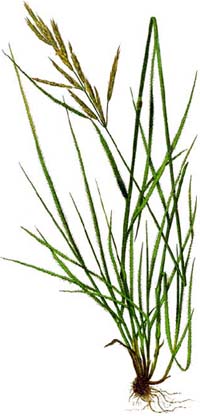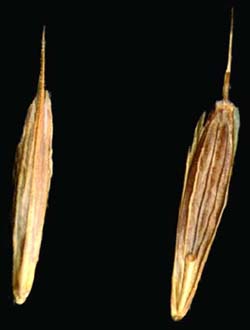Upright brome, erect brome

Bromus erectus (Schröter, 1888)
BOTANY
Perennial species, 80-100 cm high, forming dense thickets, scarcely sarmentose.
Culms are stiff, slender, erect, scarcely ascending, smooth and glabrous, up to 100 cm high.
Leaf sheaths of young shoots are crimped in the bud (not rolled like Bromus inermis), margins ciliated with long stiff hairs.
Ligules short, 2-3 mm long, lacerate.
Leaf blades of the young shoots broad, open, with 7 to 11 distinct veins and six to ten indistinct ones lying in between.
Inflorescence a panicle, narrow, 10-15 cm long, contracted, perfectly erect, with short, scabrous branches; few spikelets with the basal ones totalling two to five.
Spikelets slender, lanceolate, multiflowered (with 5 to 12 florets), 20-38 mm long.
SUITABILITY FOR RESTORATION
This European species occurs in the Alps, in the foothills and the montane zones. It requires a temperate, highly maritime climate. Upright brome grows mainly on dry, lime-rich soils. But in the Mediterranean region it prefers shady sites and moister soils. It grows also on rendzina, pararendzina, calcareous brown soils and alkaline ranker with a pH of 6.3-7.4.
General-purpose grass for restoration of drier, alkaline, nutrient-deficient sites at intermediate altitudes. Partial tolerance of cutting, sensitive to grazing and fertilization.
SEEDS
Fruit 9-11 mm long excluding awn, 1.5 mm wide, and 1-1.2 mm thick.
Lemma narrowly oblong, apically and basally acuminate, dirty straw coloured, dorsally with short or long hairs, partly glabrous.

Seeds (Blaschka, A.)
Awn 4-6 mm long, erect, originating below the apex of the lemma.
Palea irregularly spaciously ciliated at both keels, flatly grooved, a little shorter than the lemma, hyaline, colourless. In comparison to Bromus inermis the keels have longer teeth, with shorter ones lying in between.
Rachilla 1.5-3 mm long, straight, round, becoming thicker towards the apex, often with short hairs.
Fruit adhering, separable from the husks only with effort, 7-9 mm long, 1.5-2.5 mm wide and 0.5-0.7 mm thick.
Thousand seed weight: 3.2-5.5 g.
REQUIREMENTS
(soil and climate)
Like Bromus inermis, upright brome is extremely undemanding. Intermediate to light soils that are rich in humus and drier sites are suitable. It is important to select sites with little weed competition because of limited possibilities for the use of specific herbicides.
CULTIVATION
This species needs a well-prepared seedbed.
Open sowing is recommended (this is possible until the end of June if irrigation is available).
Upright brome is moderately tolerant if grown underneath a cover crop. Therefore populations of spring corn should be low density; linseed oil flax is recommended.
Seed depth: 1.5-2 cm maximum.
Seed rate: 12-15 kg/ha.
Row spacing: 25-30 cm. Broadcast sowing is also appropriate.
FERTILIZATION
Upright brome requires an intermediate amount of nutrients.
Phosphorus and potassium: on soils with an intermediate phosphorus and potassium content, basic fertilization with manure (liquid or solid, 15-25 tonnes/ha) is sufficient in autumn. Depending on soil content, fertilization with 60-80 kg/ha P2O5 and 80-120 kg/ha K2O is considered sufficient, depending on the yield.
Nitrogen: after harvesting the cover crop, or at sowing, fertilization with 30-50 kg/ha of N-total is recommended so as to obtain best development until autumn. For harvest growth, 70-80 kg/ha/y of Ntotal is necessary; to be added in autumn and early spring. If spring fertilization is carried out too late, the main result is development of the leaf mass.

Small-scale propagation stand
MAINTENANCE AND WEED CONTROL
There are special problems connected to the control of undesirable brome species. Bromus tectorum or B. sterilis accumulate especially on drier sites and it is complicated to control them.
Dense populations grow extensively until autumn of the seeding year. The timely and consistent use of herbicides is vital. Specific control of weed grasses can only be carried out by controlling single plants, or in favourable years by the temporary use of wiping wicks.
HARVEST AND YIELDS
Resistance to lodging: high.
Shattering tendency: low.
Ripeness: the spike changes colour to brown and appears to dry up. The ripeness of the seeds is determined by the nail test. Culms and leaves are still green at this point.
Ripening period: from the middle until the end of July.
Harvesting technique: direct threshing is recommended. Seeds have sufficient seed flow and can be cleaned easily.
Crop yields: yields depend largely on the cultivator’s experience. The range is between 200 and 500 kg/ha. Optimal maintenance ensures two to three harvesting years.